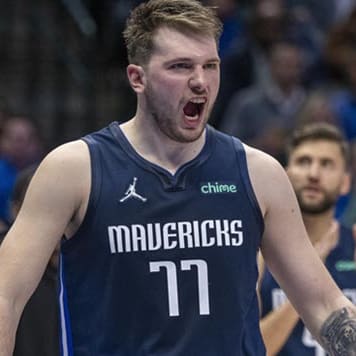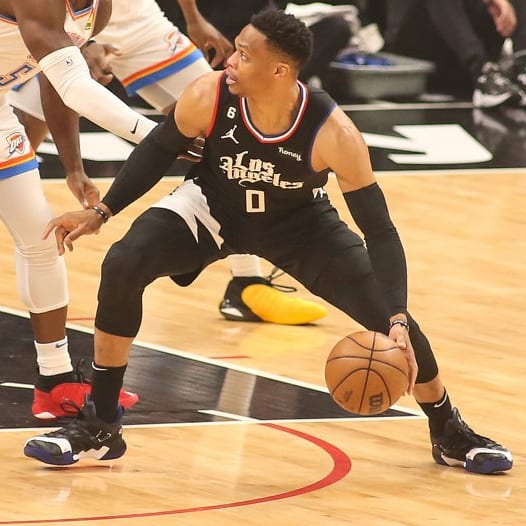This article is part of our NBA Injury Analysis series.
Kobe Bryant
The early injury questions surrounding Bryant centered around his chronic knee issues but after taking a hard fall in a preseason game against the Clippers, the focus has shifted to his right wrist. Bryant suffered a wrist sprain, specifically the lunotriquetral ligament.
In addition to the radius and ulna of the lower arm, the wrist is comprised of eight tiny bones known as the carpal bones. The lunate, a crescent-shaped bone, and the triquetrum, a pyramid-shaped bone, are two of these eight and sit in the proximal row, near the middle of the wrist. Here they articulate with one another as well as other carpal bones and the articular disc of the wrist. Both bones are completely dependent on ligaments for stability since no muscle attaches to their small surfaces. The lunotriquetral ligament directly links the two bones, providing a majority of the support. If sprained or in Bryant's case completely torn, the entire stability of the wrist is significantly weakened and wrist mobility is affected.
Surgery in Bryant's case is unwarranted but there's still plenty of concern. Even if he is able to play through the associated pain, Kobe's shooting mechanics will likely be altered, hindering his offensive game. Furthermore if he elects to play, the sprain will take longer to heal and could develop into a nagging injury. The wrist needs time to heal and will be immobilized to aid in recovery, raising questions about his status for the season opener against the Bulls.
Kobe has
Kobe Bryant
The early injury questions surrounding Bryant centered around his chronic knee issues but after taking a hard fall in a preseason game against the Clippers, the focus has shifted to his right wrist. Bryant suffered a wrist sprain, specifically the lunotriquetral ligament.
In addition to the radius and ulna of the lower arm, the wrist is comprised of eight tiny bones known as the carpal bones. The lunate, a crescent-shaped bone, and the triquetrum, a pyramid-shaped bone, are two of these eight and sit in the proximal row, near the middle of the wrist. Here they articulate with one another as well as other carpal bones and the articular disc of the wrist. Both bones are completely dependent on ligaments for stability since no muscle attaches to their small surfaces. The lunotriquetral ligament directly links the two bones, providing a majority of the support. If sprained or in Bryant's case completely torn, the entire stability of the wrist is significantly weakened and wrist mobility is affected.
Surgery in Bryant's case is unwarranted but there's still plenty of concern. Even if he is able to play through the associated pain, Kobe's shooting mechanics will likely be altered, hindering his offensive game. Furthermore if he elects to play, the sprain will take longer to heal and could develop into a nagging injury. The wrist needs time to heal and will be immobilized to aid in recovery, raising questions about his status for the season opener against the Bulls.
Kobe has a history of playing through injuries and it's hard to imagine the Lakers will enter the season without Bryant and Andrew Bynum, who will be serving a five-game suspension. Given his past track record, I would anticipate him being in the lineup on Christmas but scale back your expectations for at least a few weeks.
Brook Lopez
The Nets frontcourt took a significant hit, as Lopez will require surgery to repair a fracture in the fifth metatarsal of his right foot. The metatarsals are the long bones positioned between the bones of the midfoot and the bones of the toes. The fifth metatarsal sits on the outside of the foot where it serves as an attachment site for several muscles. These attachments make the bone very vulnerable to fractures when the ankle is forced inward in a direction known as inversion.
These types of fractures are often classified by the location of the break and the mechanism in which the injury occurred. If one of the attaching muscles causes a small piece of bone to break away, it is classified as an avulsion fraction. If the break is located near the base of the bone, it is classified as a Jones fracture. Other times, like with Lopez, a stress fracture can develop as the result of a large workload.
The blood flow to this area is incredibly poor and a fracture of this nature takes an extended period of time to adequately heal. More often than not a Jones fracture or a stress fracture requires surgery.
The success rate of the surgery varies, primarily based on position. Most guards that have suffered similar injuries have missed several months but have returned to play while others have needed extra time to heal. Last season Milwaukee's Brandon Jennings needed surgery on his fifth metatarsal and missed just 19 games over a six-week stretch. However Dallas' Rodrigue Beaubois missed the team's first 54 games recovering from the surgery. Beaubois was also a spectator for Dallas's run to the title after aggravating the injury in the regular season finale. He ultimately needed a second surgery and has just returned to the court.
The return rate on big men is worse. Due to the extra weight placed on the foot, tall, heavy athletes often require more time to heal and are more prone to reoccurrences of the injury. Pau Gasol missed three months of action in 2006 after suffering the injury while playing with the Spanish National team. Even worse, a Jones fracture is one of the foot problems that began the cascade of injuries that ultimately ended the career of Yao Ming. The Nets should anticipate being without Lopez for an extended period of time. The team traded for Mehmet Okur to help fill the void but it will be up to Deron Williams to shoulder a majority of the offensive responsibilities for New Jersey.
Jeff Green and Chuck Hayes
Green's season is over before it began but thankfully he avoided a serious and potentially life-threatening injury from occurring. At the start of the new year, Green will undergo surgery to repair an aortic aneurysm detected during his physical.
The aorta is the heart's main artery, supplying oxygenated blood to the entire body. Occasionally the normally elastic aortic wall will develop a weakness. As blood is pumped, high amounts of pressure are placed on the weakness causing it to bulge. If untreated, the bulge can rupture creating a serious and often fatal situation.
Due to their taller stature and size as well as the increased prevalence of cardiac issues in the African-American population, NBA players are more prone to heart conditions. Last week we discussed LaMarcus Aldridge and his battle with Wolf-Parkinson-White syndrome and other players including Ronny Turiaf (enlarged aortic root), Etan Thomas (leaky aortic valve), and Fred Hoiberg (aortic aneurysm) have all needed operations to treat preexisting heart conditions. Turiaf and Thomas all returned to the NBA while Hoiberg's career ended after he suffered complications that required the insertion of a pacemaker.
Fortunately the NBA and its medical advisors have been progressive about treating and identifying cardiac problems and have mandated cardiac exams like the one that detected Green's condition. Chuck Hayes also failed one of these tests but was recently cleared to play by a team of experts at the renowned Cleveland Clinic. Hayes appears set to return to the Kings while Green will attempt his comeback in 2012.
Stephen Curry
Curry gave his owners a case of déjà vu when he limped off the court after spraining his surgically repaired right ankle. A MRI revealed the repairs made remain intact and that the sprain is minor. Fantasy owners should keep in mind that reports stating the ankle is sprained but suffered no ligament damage are misleading. A sprain is exactly that, ligament damage. However the degree of the damage can vary, which is precisely why sprains are generally graded on a three-scale system. A Grade I ankle sprain is minor and occurs when a ligament and its fibers are overstretched and tearing occurs on a micro level. A Grade II is given when the ligament partially tears while a Grade III sprain involves a complete rupture. If Curry does have an ankle sprain, which he does, it's likely a Grade I sprain.
The major bit of good news here is that Curry did not damage the work done in his offseason surgery. An injury of that magnitude at this point of the season would have set his owners up for a long season. Still closely monitor the situation going forward but consider him day-to-day with an outside shot of missing the first game or two on Golden State's schedule.
Fast Breaks
JJ Barea and Ricky Rubio: Barea and Rubio didn't play in Minnesota's preseason finale dealing with injuries. Barea is nursing a bruised thigh while Rubio is battling an ankle issue. Both foreign point guards should be available for the start of the season.
Marcus Camby: Camby is getting the season started off in typical Camby fashion, nursing a sore left knee. He tweaked the knee in warm-ups for Portland's first preseason game. While his MRI was negative, it's worth mentioning that this was the same knee that needed arthroscopic surgery last season to repair a meniscus tear. Proceed with caution.
Marcin Gortat: Gortat suffered a fractured right thumb Tuesday but vows it will not keep him out. The break was non-displaced so it's reasonable to believe he can play with it wrapped and splinted.
Nene: The Brazilian center suffered a minor hamstring strain that kept him out of Thursday's preseason finale. He remains day-to-day.
Jeff Stotts is a Certified Athletic Trainer, MAT, PES and the Injury Analyst for Rotowire.com. You can follow him on twitter @RotoWireATC.










